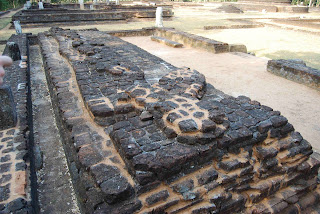Mid-morning on Monday we set off for the town of Wariyapola located NW to Kurunegala. We learned we will all be staying together with one Rotarian family - more about them in the next post.
Our cultural experience for the day was an afternoon road trip to the town of Panduwasnuwara. Located here are fortress ruins dating back to the 5th century BC, but most items unearthed here date back to the 12th century AD when this city functioned as the capital of Sri Lanka. Within the site are ruins of ancient buildings and fortifications, some of which are yet to be excavated. The function of the excavated buildings are identified by the relics located within them - worship temples, dagobas, meeting halls, living quarters, dining rooms, and even latrines have all been unearthed. While most of the valuable relics discovered here are housed in the National Museum in Colombo, there is a small archeological museum in Panduwasnuwara displaying jewelry, Buddha statues of various sizes and poses, ornate wooden pillars, bronze objects, iron nails and objects, terracotta human and animal figures, rigid tiles, clay objects, and stone objects.
Also discovered was the foundation of this city's temple that housed the Tooth Relic during its reign as capital city. The foundation is in really good shape and an ornate roof replica was added during the 1970s.
Not far from the temple is an excavated island palace surrounded by a moat. Legend has it that the multi-story palace imprisoned the king's daughter - a princess so cherished she had to be shielded from eyes of men. I couldn't quite get the translation, but apparently there was a miraculous rescue of the princess by a winged hero who flew across the moat to the island and rescued the princess. The visual evidence supports the legend, however the dates don't match. The story dates to the 5th century BC but the ruins are dated to the 12th century BC, so the legend remains unproven.



No comments:
Post a Comment